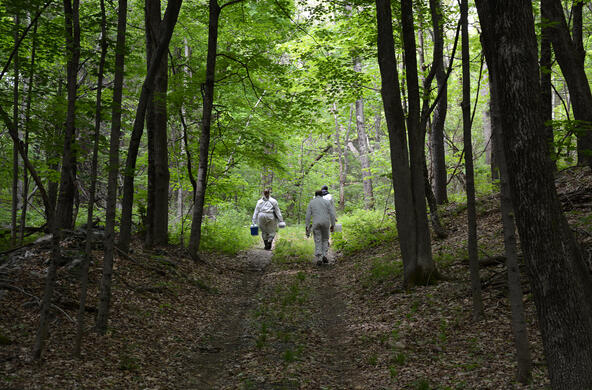Last month, over 80 distinguished scientists from around the world gathered at the Institute of Ecosystem Studies (IES) to participate in a conference on infectious disease ecology. From West Nile Virus and Ebola to Sudden Oak Death, emerging infectious diseases threaten human health, wildlife, livestock, agriculture, and forests. Once established, infectious diseases are economic and ecological burdens that can cause, in some cases, irreversible damage.
Understanding, and ultimately preventing, emerging infectious disease depends on dialogue among professionals on the front lines. The Institute’s 3-day conference, convened by Drs. Richard Ostfeld (IES), Felicia Keesing (Bard College and IES), and Valerie Eviner (IES), provided a cross-disciplinary forum for ecologists, medical doctors, veterinarians, and epidemiologists. Participant Dr. Sarah Randolph of Oxford University commented, “The conference facilitated invaluable conversation and collaboration among a diverse pool of scientists that share questions of common interest.”
An underlying theme throughout the conference was the need to incorporate ecological methods into traditional epidemiological studies. Participant Dr. Andy Dobson, an ecologist at Princeton University, noted, “When trying to unravel the infectious diseases of plants and animals, the macroscope of ecologists can provide just as much information as the microscope of microbiologists, veterinarians, and physicians. Infectious diseases exist within an ecological context.”
Traditionally, infectious disease has been viewed as a problem that is best addressed through the use of vaccines or drugs. The diverse group of experts attending the conference explored the role of disease within a big-picture framework— considering the ecological context in which disease epidemics arise, and the consequences of disease in ecological systems. One of the main topics discussed at the conference was how ecological systems influence disease dynamics.
Consider Lyme disease. The pathogen that transmits infection to humans is regulated by the presence of blacklegged ticks, deer populations, and small mammal diversity. Managing diseases with complex lifecycles, where pathogens infect multiple host species, requires an understanding of the ecological conditions that promote or inhibit disease. Dr. Felicia Keesing, one of the conference's organizers, commented, “Three quarters of emerging diseases – AIDS, Marburg, Avian Flu, etc. – arise in animals, and people become unwitting victims. We need to study disease dynamics in those animal populations.”
Animal populations and the diseases they harbor are strongly influenced by environmental changes. Over the past several centuries, the progression of human society has dramatically altered the ecological landscape. From large- scale land modification to the global movement of people, animals, and plants— very few ecosystems can be considered remote or pristine. These environmental changes can enhance or inhibit the development of certain diseases.
The conference also explored how ecological methods and perspectives could be used to advance our ability to both manage and predict infectious diseases in humans, wildlife, natural plant communities and agriculture. Dr. Sharon Deem, a veterinarian at the Smithsonian Institution, noted, “Incorporating ecological approaches into the infectious disease framework will strengthen our ability to respond to emerging pathogens.”
This sentiment was reinforced by Whirling Disease Foundation virologist Dr. Karl John- son, co-discoverer of Ebola and Hantavirus, “Our planet is supporting a population of 6.5 billion, with a projected 9.1 billion in 2050. As borders and ecological boundaries shrink, the divide between theoretical ecology and applied epidemiology is also shrinking. Successfully addressing the infectious diseases of the future will require building a bridge between both sides of the disease equation— epidemiology and ecology.”
The dialogue fostered by the conference gave rise to a number of promising new education and research agendas. These include hiring ecologists in schools of public health, sharing disease ecology findings with health and veterinarian practitioners, developing interdisciplinary graduate programs to train the next generation of medical and ecological professionals, and holding future cross-discipline conferences. Conference proceedings will be published in a book, Infectious Disease Ecology, available in 2006.
Funding for the conference was made possible through support from the National Science Foundation, Dutchess County, Doris Duke Charitable Foundation, the U.S. Department of Agriculture, the National Oceanographic and Atmospheric Administration, and the Institute of Ecosystem Studies.
Dutchess County Executive William R. Steinhaus noted the conference's local relevance, “Dutchess County recognizes the importance of understanding infectious disease ecology, both globally and locally. We are pleased to support the Institute of Ecosystem Studies’ efforts in promoting a broader awareness of the role that ecology plays in informing the management and prevention of infectious disease.”






